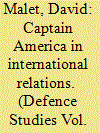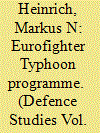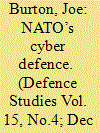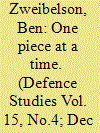| Srl | Item |
| 1 |
ID:
142258


|
|
|
|
|
| Summary/Abstract |
Biological weapons are typically associated with rogue states and terrorist groups; germ weapons used by weak actors against the strong. This article makes a contrary argument, that the emerging use of biotechnology by the United States, China, and other hegemonic powers is likely to afford them a new Revolution in Military Affairs (RMA), one at least as significant as the introduction of the information technology RMA that gave the United States a dominant edge over potential adversaries at the end of the Cold War. It examines recent developments and current R&D programs that call into question the rights of enemy combatants, civilian populations in target areas, and soldiers who will be physically augmented to pursue battlefield objectives. Examples include the Quikclot used to reduce fatalities in the Iraq War, which arguably prolonged public support for the war, and the Pentagon’s publicly detailed research across various programs to create super-soldiers akin to super-heroes. The real advances in biotech will likely only further retrench the major powers of the international system by conferring an asymmetric advantage far beyond the capacity of weaker actors to match.
|
|
|
|
|
|
|
|
|
|
|
|
|
|
|
|
| 2 |
ID:
142259


|
|
|
|
|
| Summary/Abstract |
This article analyses the economic and industrial implications of the Eurofighter Typhoon programme. In an era of progressive reductions in European defence expenditure and exponentially increasing sophistication and cost of modern weapon systems development, European nations have pooled their resources for this major defence project. Although being founded on a sound concept, the Eurofighter programme has faced difficulties in the form of cost overruns, and the aircraft has been troubled by system defects and shortcomings in its air-to-ground capabilities, the combination of which has earned it critics, adversely affected its export record and cast doubt over its future. However, the Typhoon is a highly capable fighter, and sensor and weapons upgrades are increasingly bringing it closer to fulfilling its multi-role potential. The programme’s importance also goes beyond the aircraft itself and the capability its possession affords, as it supports a large number of highly skilled jobs and therefore has far-reaching implications for Europe maintaining the conditions and skills necessary for a competitive and independent indigenous fighter-aircraft manufacturing capacity.
|
|
|
|
|
|
|
|
|
|
|
|
|
|
|
|
| 3 |
ID:
142257


|
|
|
|
|
| Summary/Abstract |
NATO’s adaptation in the post-cold war era has included a growing role in responding to cyber attacks. This article explores the definitional and theoretical problems in analysing the emerging cyber security field and seeks to provide an outline of the main strategic challenges that cyber attacks pose for NATO. The article evaluates the institutional structures and processes put in place by NATO to confront cyber threats and moves on to explore the extent of transatlantic unity around NATO’s emerging doctrine for cyber defence. It is argued that NATO’s response to cyber security is rooted in its prior adaptation to the changing security environment of the 1990s and the threat from international terrorism post 9-11. More recently, cyber attacks from state and state-sponsored actors have given impetus to NATO’s emerging cyber security doctrine. The article finds that despite recent controversies over cyber surveillance, there is a considerable degree of unity within the alliance on the main cyber security issues. As a multilateral security organisation with a strong institutional foundation, NATO is also relatively well placed to respond to rapidly evolving cyber threats.
|
|
|
|
|
|
|
|
|
|
|
|
|
|
|
|
| 4 |
ID:
142260


|
|
|
|
|
| Summary/Abstract |
The recent strategic failures in Iraq and Afghanistan for military coalitions illustrate that we have significant problems with understanding how and why we plan military campaigns in ways that over time demonstrate ineffectiveness and confusion. Arguably, we may not realize why we construct insufficient campaign plans because we are not even aware of our cognitive behaviors. This article critically charges that our entire approach to understanding conflict and our subsequent military planning methodologies stem from highly limited yet deeply cherished conceptual models that operate behind the scenes. We hardly realize them, yet they dominate our very understanding of how we imagine the world functions. With military campaign plans, our centralized hierarchies, linear causality reasoning, and other significant sociological forces send us into cycles of poor planning along with institutional blinders that resist critical reflection on why we are failing.
|
|
|
|
|
|
|
|
|
|
|
|
|
|
|
|